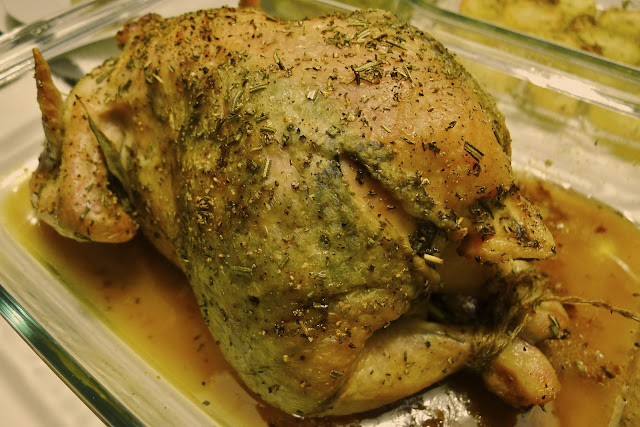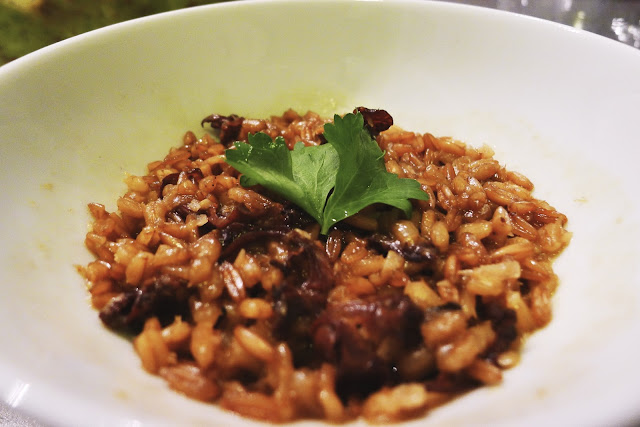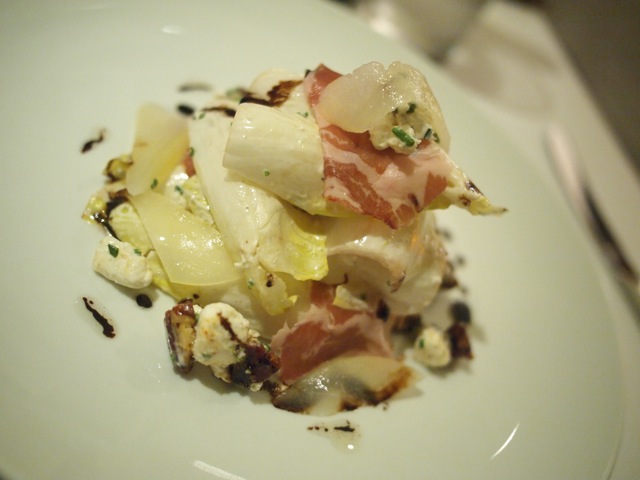Fraiche recently experienced a rebirth under Chef Benjamin Bailly. My overall impression of the chef is that he does really well with pastas and seafood. Really, really well. Though the tasting menu had it's low points, its high points were more than memorable enough to make this dining experience very special. I got there a little early, so I had enough time to grab a cocktail. I got the Frisky Sour, but asked the bartender if she could make it a little more seasonal. The product was basically a traditional pisco sour shaken with egg whites and topped with just enough nutmeg. I could have downed the whole flute in a second, but I stretched myself to eight restrained sips.
Once we were seated, the server handed us copies of the planned tasting menu for the night.
The night started off with some bright Green Olives. They were oily, fresh, slightly acidic, and bitter, reminding me of the olives I ate every day in Spain. They were a great way to jump start the taste buds.
Next was the amuse bouche. The Wild Mushroom Soup was creamy, hearty, and rich. The soup started off tasting like any other cream of mushroom soup, but it quickly revealed more rustic and robust flavors that could only come from fresh, earthy mushrooms. The flavors spread throughout my mouth with every sip. Bouche amused.
The Hamachi Tartare with Shaved Turnip, Lime, and Espilette Pepper was one of my favorite dishes of the night. Prepared in a way that reminded me of Jose Andrés' Jicama Wrapped Guacamole, this dish was light and refreshing. Floating between two paper-thin sheets of turnip, the freshly diced yellowtail's flavors shone through with very light acidity and barely noticeable spice. The dish was simple, pure, and fresh, with nothing overpowering anything on the dish.
As the next dish passed by my face on its way down to the table, I could already smell the truffle vinaigrette.
The Belgian Endives with Duck Bresaola, Quince, Pecan, Goat Cheese, and a Truffle Vinaigrette was an interesting way of combining typically heavier ingredients into a lighter salad. The Belgian endives had a great, bitter kick to each bite that measured up to the strength of the truffle vinaigrette. The duck bresaola was sliced thin enough to complement, rather than weigh down, the goat cheese. The nutty pecans and the lightly floral, but flavorful, quince added a great balance among all of the dish's elements. With the right amount of each ingredient, this quickly became an addictive salad. That said, I love truffles, but I think overall I could have used a little bit less of the vinaigrette.
Next up was one of the best pastas I've ever had, and eating this meal within days after Scott Conant's spaghetti at Scarpetta made that tough.
The Taglieneri Neri with Maine Lobster, Cherry Tomatoes, and Basil came out with a beautiful, juicy piece of lobster sitting on top, accompanied by tomatoes that were just as juicy. I love squid ink pasta, and this squid ink pasta was a force to be reckoned with. The pasta and the lobster made for some great, seafood flavors, while the cherry tomatoes and basil added some really great bright notes to the dish. The brightness made the pasta feel lighter than it probably was and left me wanting more. But sadly, I had to say goodbye and move on to pasta number two.
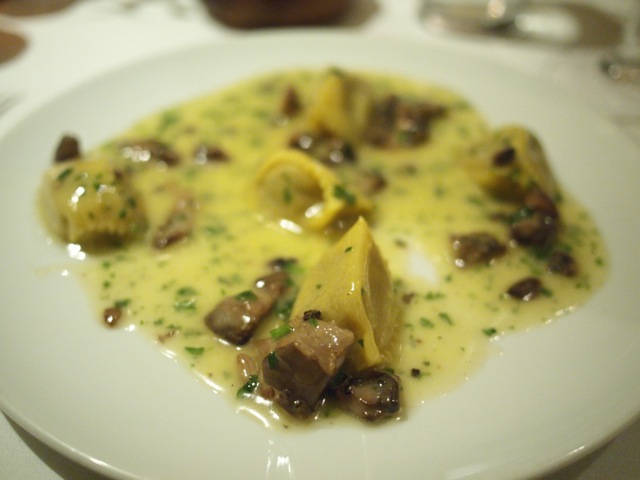
The House-Made Agnolotti with Wild Mushrooms, Mascarpone, and Truffle Butter was heavy, in the best way possible. The fresh agnolotti was to die for, and each agnolotti bursted with mascarpone juices and deep mushroom flavors with each bite, which reminded me of the amuse from earlier. I love mushrooms, if you haven't caught onto that already, and if mushrooms are exploding out of agnolottis into my mouth like juicy pork does out of Taiwanese soup dumplings, that's probably a good thing.
Sorry for the necessarily fungal description. The truffle butter sauce was also incredible. The truffle flavor wasn't overpowering and the creamy butter sauce was so good, the waiter brought us some bread to sop up the remaining sauce.
You could even say we "scarpetta'd" the remnants of the sauce. Needless to say, the butter that came with the bread went untouched.
The first of the three proteins was the best of the three proteins.
The Crispy Loup De Mer with Sunchokes Soubise, Crosnes, Salsify, Mushrooms, and Bordelaise featured a perfectly cooked fish. Crispy on the outside and delicate on the inside, the fish sat on a beautiful bed of salsify, mushrooms, crosnes, and a thick sunchoke soubise. The earthy base complemented the oceanic flavors from the fish and were furthered by the bordelaise, adding a sweet, yet dry element to the dish.
By the second main protein, I was about to keel over from a food coma. The diner sitting at the table next to us commented on our progress and asked if we had finished every single dish until that point. We had. Lucky for us, the next dish was the heaviest.
Everything about the Roasted Pork Chop with Artichokes, Tomato, Chorizo, and Romesco was great, except for the roasted pork chop. The chop was chewy and tough to get through. The romesco, on the other hand, was beautiful, and went well with the chorizo and tomatoes. The artichokes were okay, but not memorable. The dish also could have benefited from some acidity, like a squeeze of lemon. Unfortunately, the bordelaise was insufficient to bring the dish together and was altogether unnecessary. This was the first dish we didn't finish. The chops were half-eaten at most.
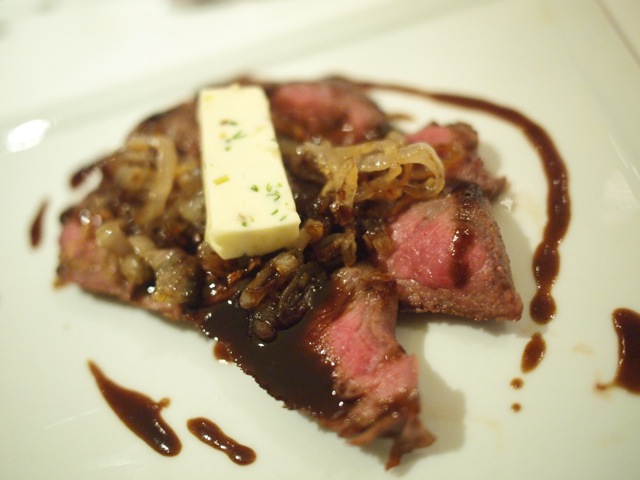
The last dish was also heavy. With the Prime New York Strip Steak Frites with Shallot Fondue and a Red Wine Jus, the steak was perfectly cooked, but the frites were forgettable. The shallot fondue was delicious, and benefited from the slice of butter sitting on top, but by the last dish, I was sick of the bordelaise sauce. If this dish had been the only dish I had tried with the bordelaise, I might have looked more favorably on it, but even then, I think this dish could be pared down to just a simple set of steak, butter, and shallots. With several fries left on our plates, we finally made our way to our second stomachs.
The first dessert was more of a palate cleanser than anything.
The menu promised a raspberry compote and crushed pistachios with our dessert, but we only got a Meyer Lemon Sorbet with Beefeater Gin. This was a pretty tough "dessert" to swallow. The sorbet that peeked above the pool of gin was good, but the gin was too overpowering to balance well with the remaining sorbet. I can't speak to the original concept for the dish, but I'm assuming it tastes better when fully realized.
The next dessert was delicious.
The Panettone Bread Pudding with Gianduja, Candied Hazelnuts, and Mascarpone Gelato featured a sufficiently moist bread pudding with sweet pockets of hazelnut chocolate gianduja. The candied hazelnuts were great, but the star of the dish was really the mascarpone gelato.
The refreshing creaminess of the mascarpone balanced perfectly with the sweet and warm bread pudding, and the beautiful caramel drizzle was a great way to bring together the pudding and the gelato.
Last up to bat was the heaviest item on the entire menu: Chocolate Coulant with Toffee and Peanut Butter Ice Cream. Despite its weight, we did our best to eat as much as we could. The chocolate coulant oozed with warm chocolate with the first slice, and the chocolate mixed together with the slowly melting peanut butter ice cream.
Peanut butter and chocolate is one of those combinations that never gets old. Throw in some crunchy toffee brittle for texture and you've got yourself a winner. The peanuts added some texture as well, and the light chocolate drizzle made sure you weren't missing out on any chocolate with every bite of the peanut butter ice cream, peanuts, and toffee.
Overall, this was a great menu. Chef Benjamin Bailly shares some familiar dishes with innovative twists and precise execution. Even though there were a few forgettable moments over the course of a delicious night, and even though we left the restaurant with food nearing the top of my esophagus, I would definitely go again. The menu featured fresh seafood, delicious pastas, seasonal ingredients, and updated, rustic European food.
Right before going to this dinner at Fraiche, a friend of mine jokingly said that Fraiche was "so 2007." Under Chef Benjamin Bailly's new direction, I have no hesitation in saying that Fraiche is now very 2011.
Special thanks to effing dericious for sharing his photos with me. This is the last batch of photos that I lost from someone stealing my camera.
Fraiche
9411 Culver Blvd
Culver City, CA 90232
(310) 839-6800
GET: One tasting menu among at least four people; Hamachi Tartare with Shaved Turnip, Lime, and Espilette Pepper; Taglieneri Neri with Maine Lobster, Cherry Tomatoes, and Basil; House-Made Agnolotti with Wild Mushrooms, Mascarpone, and Truffle Butter; Crispy Loup De Mer with Sunchokes Soubise, Crosnes, Salsify, Mushrooms, and Bordelaise; Panettone Bread Pudding with Gianduja, Candied Hazelnuts, and Mascarpone Gelato; Chocolate Coulant with Toffee and Peanut Butter Ice Cream.
